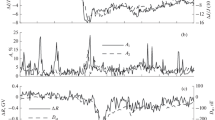Abstract
We consider the influence of the physical processes arising as results of atomic explosions on the meteorological factors of the earth's atmosphere. Calculations based on an analysis of the existing data show that the thermodynamical effect of an explosion is insignificant and can have no important effect on meteorological processes. Some changes of weather can be caused indirectly by the considerable disturbance of the electrical properties of the atmosphere and the consequent intensification of processes of condensation. In order of magnitude these changes may be comparable with the changes of weather caused by the periodic variations of solar activity.
Similar content being viewed by others
Literature cited
L. Machta and D.L. Harris, Science 121, 3134, 75 (1955).
Habert Garrigue, Comptes rend. 232, 10, 1003 (1951).
B.J. Mason, Weather 5, 139 (1955).
B. Holzman, Weatherwise 4, 1, 3 (1951).
J. Roy, Astr. Soc. Can. 47, 6, 253 (1953).
Horst Teichmann, Naturwissenschaften 41, 21, 498 (1954).
Charles-Noel Mortin, Compt. rend. 239, 20, 1287 (1954).
Pravda, July 8, 1954.
The Effect of Atomic Weapons, Atomic Energy Commission (Washington, 1950).
Howard L. Andrews, Science 122, 3167, 453 (1955).
R. Braham Roscoe, Jr., J. Meteorol. 9, 4, 227 (1952).
N.I. Vulfson, Proc. Acad. Sci. USSR 97, 1, 77 (1954).
H. Wexler, Bull. Am. Meteorol. Soc. 32, 1, 10 (1953).
H. Wexler. Bull. Am. Meteorol. Soc. 32, 2, 48 (1951).
W.J. Humphreys, Physics of the Air (New York, 1940).
Willard F. Libby, Bull. Atomic Scientists XI, 7, 256 (1955).
Neuwirth, Geofisica pura e applicata 32, 3, 147 (1955).
Yasuchi Nishiwaki, Atom. Scient. J. 4, 5, 279 (1955).
D. Lee Harris, J. Geophys. Research 60, 1 (1955).
L.M. Levin, Proc. Acad. Sci. USSR 94, 3, 462 (1954).
Eigenson, Gnevyshev, Ol and Rubashev, Solar Activity and Its Terrestrial Manifestations (Moscow-Leningrad, 1948).
I.V. Maksimov, Bull. Acad. Sci. USSR, Geog. Ser. No. 1, 15 (1954).
A.A. Dmitriev, G.V. Bonchkovskaia and G.A. Kalinina, Proc. Acad. Sci. USSR 103, 4, 597 (1955).
A.A. Dmitriev, Meteorology and Hydrology. 1949, 5.
A.A. Dmitriev, “Consideration of some modes of action of solar activity on the circulation of the atmosphere,” Bull. Acad. Sci. USSR, Geophys. Ser. (in press).
Staff members of the Forecast Research Laboratory, Geophys. Mag. (Tokyo) 26, 3, 231 (1955).
E.G. Bowly, J. Meteorol. 13, 2, 142 (1956).
Rights and permissions
About this article
Cite this article
Fedorov, E.K. On the influence of atomic explosions on meteorological processes. The Soviet Journal of Atomic Energy 1, 779–788 (1956). https://doi.org/10.1007/BF01480914
Received:
Issue Date:
DOI: https://doi.org/10.1007/BF01480914



